Analysis of ISO Regulations Impact on Stakeholders in Saudi Arabia
VerifiedAdded on 2020/02/03
|6
|1181
|283
Report
AI Summary
This report examines the significant impact of ISO regulations on various stakeholders, including future investors, local stakeholders, and the government. It delves into how ISO 14001 and AA1000 regulations function to safeguard stakeholder interests, emphasizing environmental management and accountability. The analysis includes specific examples from the Kingdom of Saudi Arabia, illustrating the practical application of these regulations through the Saudi Arabian Standards Organization (SASO) and its adoption of ISO 9000. The report highlights the benefits of ISO standards in ensuring product quality, safety, and facilitating international trade, thereby enhancing corporate survival and stakeholder satisfaction. The study underscores the importance of adhering to international standards in today's competitive business environment, contributing to ethical business practices and sustainable development. The report provides a comprehensive overview of how these standards influence the relationship between businesses and their stakeholders, fostering trust, and promoting long-term success.
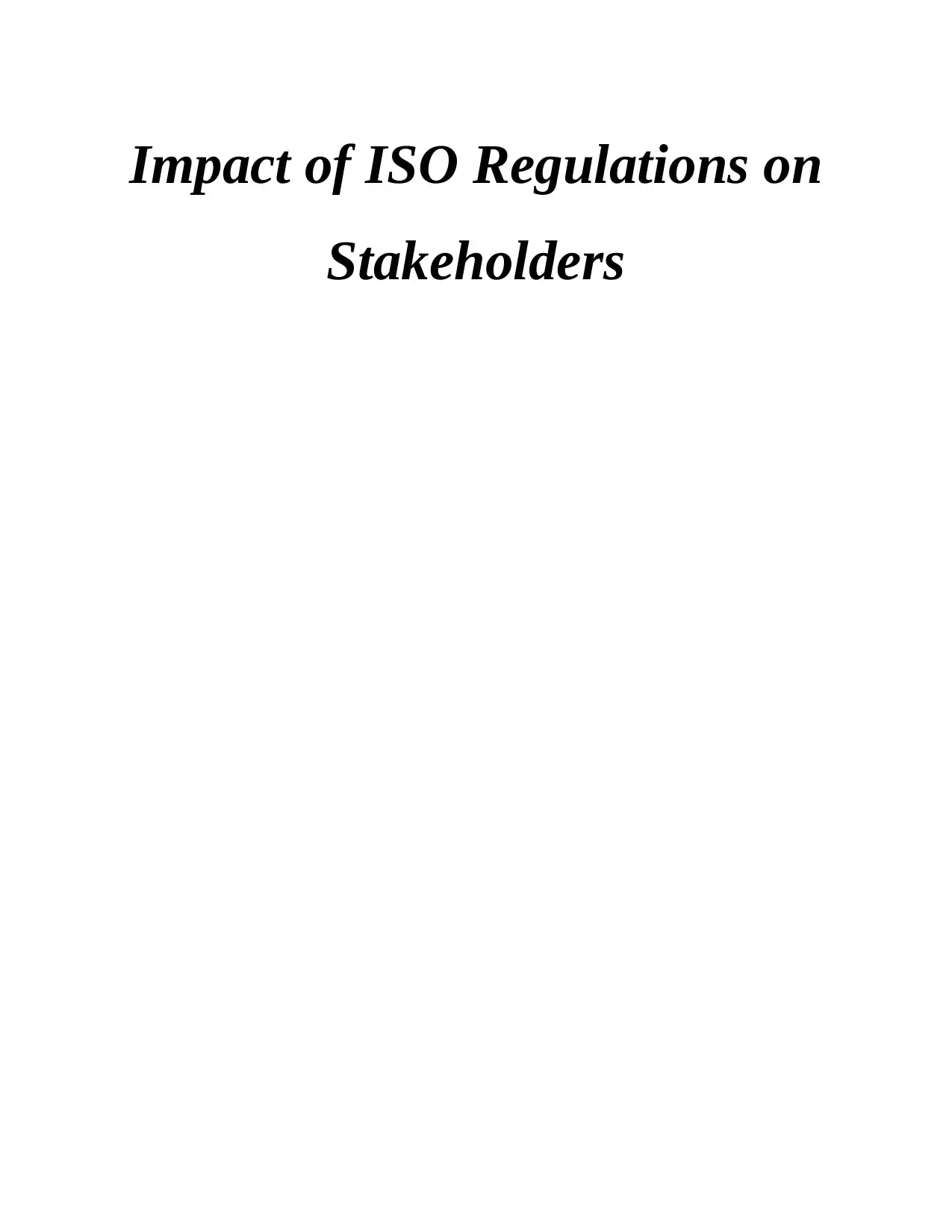
Impact of ISO Regulations on
Stakeholders
Stakeholders
Paraphrase This Document
Need a fresh take? Get an instant paraphrase of this document with our AI Paraphraser
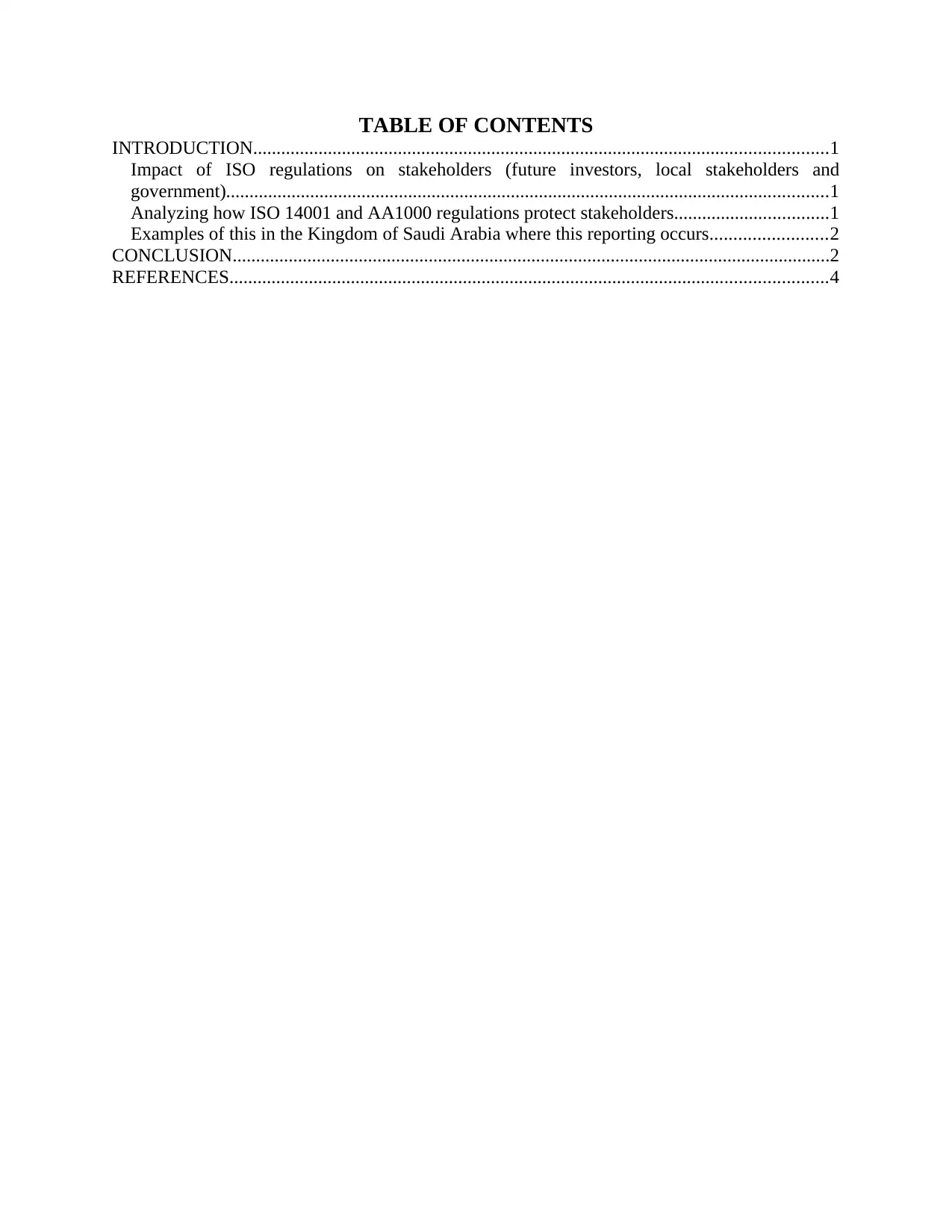
TABLE OF CONTENTS
INTRODUCTION...........................................................................................................................1
Impact of ISO regulations on stakeholders (future investors, local stakeholders and
government).................................................................................................................................1
Analyzing how ISO 14001 and AA1000 regulations protect stakeholders.................................1
Examples of this in the Kingdom of Saudi Arabia where this reporting occurs.........................2
CONCLUSION................................................................................................................................2
REFERENCES................................................................................................................................4
INTRODUCTION...........................................................................................................................1
Impact of ISO regulations on stakeholders (future investors, local stakeholders and
government).................................................................................................................................1
Analyzing how ISO 14001 and AA1000 regulations protect stakeholders.................................1
Examples of this in the Kingdom of Saudi Arabia where this reporting occurs.........................2
CONCLUSION................................................................................................................................2
REFERENCES................................................................................................................................4
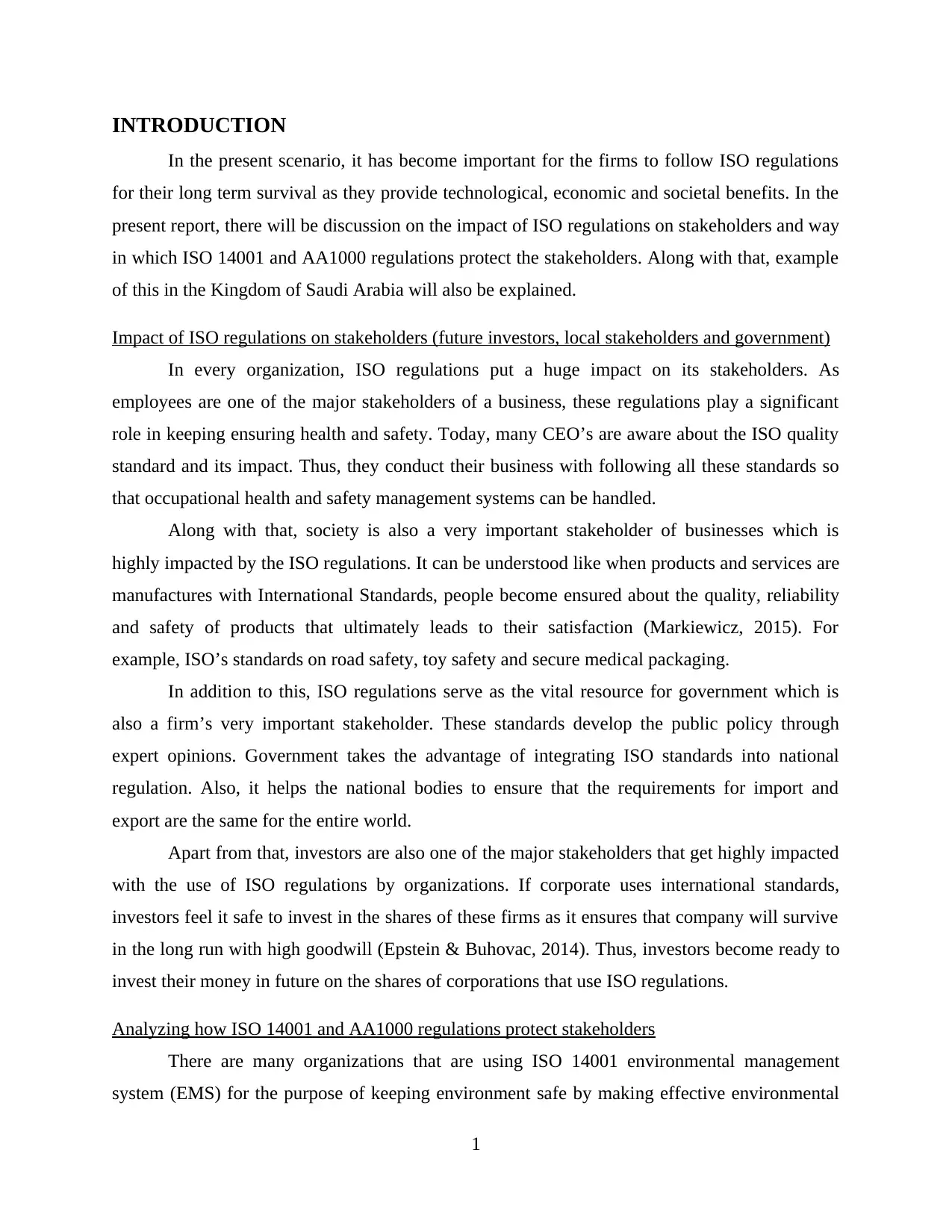
INTRODUCTION
In the present scenario, it has become important for the firms to follow ISO regulations
for their long term survival as they provide technological, economic and societal benefits. In the
present report, there will be discussion on the impact of ISO regulations on stakeholders and way
in which ISO 14001 and AA1000 regulations protect the stakeholders. Along with that, example
of this in the Kingdom of Saudi Arabia will also be explained.
Impact of ISO regulations on stakeholders (future investors, local stakeholders and government)
In every organization, ISO regulations put a huge impact on its stakeholders. As
employees are one of the major stakeholders of a business, these regulations play a significant
role in keeping ensuring health and safety. Today, many CEO’s are aware about the ISO quality
standard and its impact. Thus, they conduct their business with following all these standards so
that occupational health and safety management systems can be handled.
Along with that, society is also a very important stakeholder of businesses which is
highly impacted by the ISO regulations. It can be understood like when products and services are
manufactures with International Standards, people become ensured about the quality, reliability
and safety of products that ultimately leads to their satisfaction (Markiewicz, 2015). For
example, ISO’s standards on road safety, toy safety and secure medical packaging.
In addition to this, ISO regulations serve as the vital resource for government which is
also a firm’s very important stakeholder. These standards develop the public policy through
expert opinions. Government takes the advantage of integrating ISO standards into national
regulation. Also, it helps the national bodies to ensure that the requirements for import and
export are the same for the entire world.
Apart from that, investors are also one of the major stakeholders that get highly impacted
with the use of ISO regulations by organizations. If corporate uses international standards,
investors feel it safe to invest in the shares of these firms as it ensures that company will survive
in the long run with high goodwill (Epstein & Buhovac, 2014). Thus, investors become ready to
invest their money in future on the shares of corporations that use ISO regulations.
Analyzing how ISO 14001 and AA1000 regulations protect stakeholders
There are many organizations that are using ISO 14001 environmental management
system (EMS) for the purpose of keeping environment safe by making effective environmental
1
In the present scenario, it has become important for the firms to follow ISO regulations
for their long term survival as they provide technological, economic and societal benefits. In the
present report, there will be discussion on the impact of ISO regulations on stakeholders and way
in which ISO 14001 and AA1000 regulations protect the stakeholders. Along with that, example
of this in the Kingdom of Saudi Arabia will also be explained.
Impact of ISO regulations on stakeholders (future investors, local stakeholders and government)
In every organization, ISO regulations put a huge impact on its stakeholders. As
employees are one of the major stakeholders of a business, these regulations play a significant
role in keeping ensuring health and safety. Today, many CEO’s are aware about the ISO quality
standard and its impact. Thus, they conduct their business with following all these standards so
that occupational health and safety management systems can be handled.
Along with that, society is also a very important stakeholder of businesses which is
highly impacted by the ISO regulations. It can be understood like when products and services are
manufactures with International Standards, people become ensured about the quality, reliability
and safety of products that ultimately leads to their satisfaction (Markiewicz, 2015). For
example, ISO’s standards on road safety, toy safety and secure medical packaging.
In addition to this, ISO regulations serve as the vital resource for government which is
also a firm’s very important stakeholder. These standards develop the public policy through
expert opinions. Government takes the advantage of integrating ISO standards into national
regulation. Also, it helps the national bodies to ensure that the requirements for import and
export are the same for the entire world.
Apart from that, investors are also one of the major stakeholders that get highly impacted
with the use of ISO regulations by organizations. If corporate uses international standards,
investors feel it safe to invest in the shares of these firms as it ensures that company will survive
in the long run with high goodwill (Epstein & Buhovac, 2014). Thus, investors become ready to
invest their money in future on the shares of corporations that use ISO regulations.
Analyzing how ISO 14001 and AA1000 regulations protect stakeholders
There are many organizations that are using ISO 14001 environmental management
system (EMS) for the purpose of keeping environment safe by making effective environmental
1
⊘ This is a preview!⊘
Do you want full access?
Subscribe today to unlock all pages.

Trusted by 1+ million students worldwide
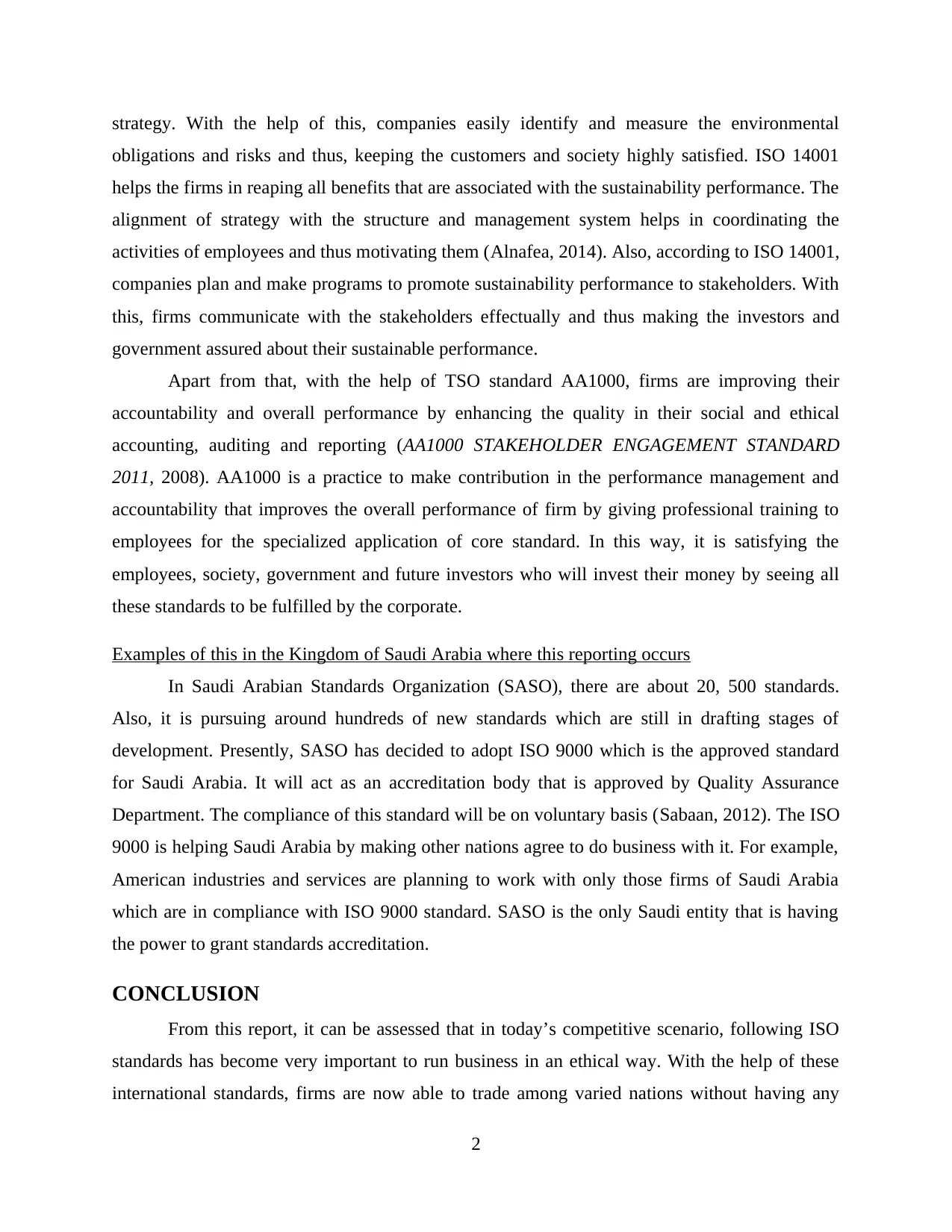
strategy. With the help of this, companies easily identify and measure the environmental
obligations and risks and thus, keeping the customers and society highly satisfied. ISO 14001
helps the firms in reaping all benefits that are associated with the sustainability performance. The
alignment of strategy with the structure and management system helps in coordinating the
activities of employees and thus motivating them (Alnafea, 2014). Also, according to ISO 14001,
companies plan and make programs to promote sustainability performance to stakeholders. With
this, firms communicate with the stakeholders effectually and thus making the investors and
government assured about their sustainable performance.
Apart from that, with the help of TSO standard AA1000, firms are improving their
accountability and overall performance by enhancing the quality in their social and ethical
accounting, auditing and reporting (AA1000 STAKEHOLDER ENGAGEMENT STANDARD
2011, 2008). AA1000 is a practice to make contribution in the performance management and
accountability that improves the overall performance of firm by giving professional training to
employees for the specialized application of core standard. In this way, it is satisfying the
employees, society, government and future investors who will invest their money by seeing all
these standards to be fulfilled by the corporate.
Examples of this in the Kingdom of Saudi Arabia where this reporting occurs
In Saudi Arabian Standards Organization (SASO), there are about 20, 500 standards.
Also, it is pursuing around hundreds of new standards which are still in drafting stages of
development. Presently, SASO has decided to adopt ISO 9000 which is the approved standard
for Saudi Arabia. It will act as an accreditation body that is approved by Quality Assurance
Department. The compliance of this standard will be on voluntary basis (Sabaan, 2012). The ISO
9000 is helping Saudi Arabia by making other nations agree to do business with it. For example,
American industries and services are planning to work with only those firms of Saudi Arabia
which are in compliance with ISO 9000 standard. SASO is the only Saudi entity that is having
the power to grant standards accreditation.
CONCLUSION
From this report, it can be assessed that in today’s competitive scenario, following ISO
standards has become very important to run business in an ethical way. With the help of these
international standards, firms are now able to trade among varied nations without having any
2
obligations and risks and thus, keeping the customers and society highly satisfied. ISO 14001
helps the firms in reaping all benefits that are associated with the sustainability performance. The
alignment of strategy with the structure and management system helps in coordinating the
activities of employees and thus motivating them (Alnafea, 2014). Also, according to ISO 14001,
companies plan and make programs to promote sustainability performance to stakeholders. With
this, firms communicate with the stakeholders effectually and thus making the investors and
government assured about their sustainable performance.
Apart from that, with the help of TSO standard AA1000, firms are improving their
accountability and overall performance by enhancing the quality in their social and ethical
accounting, auditing and reporting (AA1000 STAKEHOLDER ENGAGEMENT STANDARD
2011, 2008). AA1000 is a practice to make contribution in the performance management and
accountability that improves the overall performance of firm by giving professional training to
employees for the specialized application of core standard. In this way, it is satisfying the
employees, society, government and future investors who will invest their money by seeing all
these standards to be fulfilled by the corporate.
Examples of this in the Kingdom of Saudi Arabia where this reporting occurs
In Saudi Arabian Standards Organization (SASO), there are about 20, 500 standards.
Also, it is pursuing around hundreds of new standards which are still in drafting stages of
development. Presently, SASO has decided to adopt ISO 9000 which is the approved standard
for Saudi Arabia. It will act as an accreditation body that is approved by Quality Assurance
Department. The compliance of this standard will be on voluntary basis (Sabaan, 2012). The ISO
9000 is helping Saudi Arabia by making other nations agree to do business with it. For example,
American industries and services are planning to work with only those firms of Saudi Arabia
which are in compliance with ISO 9000 standard. SASO is the only Saudi entity that is having
the power to grant standards accreditation.
CONCLUSION
From this report, it can be assessed that in today’s competitive scenario, following ISO
standards has become very important to run business in an ethical way. With the help of these
international standards, firms are now able to trade among varied nations without having any
2
Paraphrase This Document
Need a fresh take? Get an instant paraphrase of this document with our AI Paraphraser

issue as ISO standards give them legal permit to trade with different nations. These standards
give surety about quality and safety with respect to use the products. Thus, they play a significant
role in satisfying the stakeholders which increases the period of survival of corporate.
3
give surety about quality and safety with respect to use the products. Thus, they play a significant
role in satisfying the stakeholders which increases the period of survival of corporate.
3
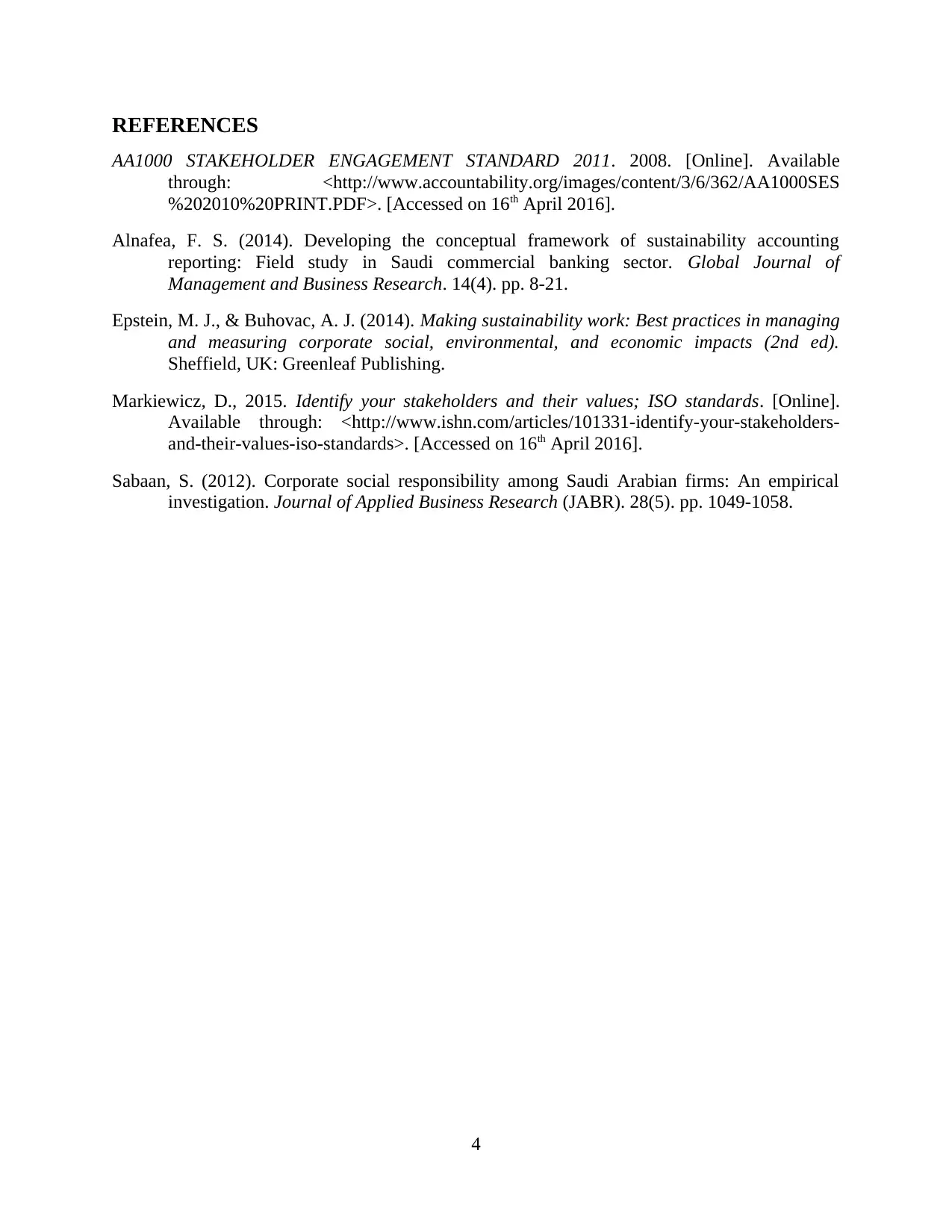
REFERENCES
AA1000 STAKEHOLDER ENGAGEMENT STANDARD 2011. 2008. [Online]. Available
through: <http://www.accountability.org/images/content/3/6/362/AA1000SES
%202010%20PRINT.PDF>. [Accessed on 16th April 2016].
Alnafea, F. S. (2014). Developing the conceptual framework of sustainability accounting
reporting: Field study in Saudi commercial banking sector. Global Journal of
Management and Business Research. 14(4). pp. 8-21.
Epstein, M. J., & Buhovac, A. J. (2014). Making sustainability work: Best practices in managing
and measuring corporate social, environmental, and economic impacts (2nd ed).
Sheffield, UK: Greenleaf Publishing.
Markiewicz, D., 2015. Identify your stakeholders and their values; ISO standards. [Online].
Available through: <http://www.ishn.com/articles/101331-identify-your-stakeholders-
and-their-values-iso-standards>. [Accessed on 16th April 2016].
Sabaan, S. (2012). Corporate social responsibility among Saudi Arabian firms: An empirical
investigation. Journal of Applied Business Research (JABR). 28(5). pp. 1049-1058.
4
AA1000 STAKEHOLDER ENGAGEMENT STANDARD 2011. 2008. [Online]. Available
through: <http://www.accountability.org/images/content/3/6/362/AA1000SES
%202010%20PRINT.PDF>. [Accessed on 16th April 2016].
Alnafea, F. S. (2014). Developing the conceptual framework of sustainability accounting
reporting: Field study in Saudi commercial banking sector. Global Journal of
Management and Business Research. 14(4). pp. 8-21.
Epstein, M. J., & Buhovac, A. J. (2014). Making sustainability work: Best practices in managing
and measuring corporate social, environmental, and economic impacts (2nd ed).
Sheffield, UK: Greenleaf Publishing.
Markiewicz, D., 2015. Identify your stakeholders and their values; ISO standards. [Online].
Available through: <http://www.ishn.com/articles/101331-identify-your-stakeholders-
and-their-values-iso-standards>. [Accessed on 16th April 2016].
Sabaan, S. (2012). Corporate social responsibility among Saudi Arabian firms: An empirical
investigation. Journal of Applied Business Research (JABR). 28(5). pp. 1049-1058.
4
⊘ This is a preview!⊘
Do you want full access?
Subscribe today to unlock all pages.

Trusted by 1+ million students worldwide
1 out of 6
Related Documents
Your All-in-One AI-Powered Toolkit for Academic Success.
+13062052269
info@desklib.com
Available 24*7 on WhatsApp / Email
![[object Object]](/_next/static/media/star-bottom.7253800d.svg)
Unlock your academic potential
Copyright © 2020–2025 A2Z Services. All Rights Reserved. Developed and managed by ZUCOL.




